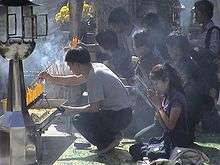Dhupa
| |||||
Dhupa (धुप) is, in Indian religions (such as Hinduism, Buddhism, Jainism, etc.), the ritual offering of incense during puja to an image of a deity, or other object of veneration. It is also the Sanskrit word for incense or perfume itself.
Thai language also borrows this word from Sanskrit to call joss sticks or incense sticks, by omitting "a" in the word Dhupa. So, the word retains the Sanskrit form when it is written in Thai alphabet as "Dhup" (ธูป). However, Sanskrit's Dh ([d̪ʱ]) is pronounced as aspirated T [tʰ] in Thai, the word is normally pronounced or transliterated as "Thup" ( [tʰûːp]). Incense burning before images, in temples and during prayer practice is also found in many parts of Asia, among followers of Jainism, Sikhism, Buddhism and Taoism.
The very idea of offering dhupa is personified in the dakini Dhupa, who is said in the Bardo Thödol to appear on the third day.[1]


.jpg)